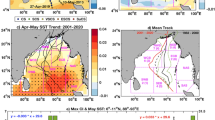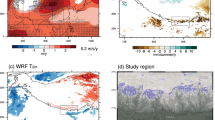Abstract
DEPRESSIONS of the Bay of Bengal are an important component of the south-west monsoon circulation. Moving WNW, they account for much of the rainfall in India. Synoptic conditions favouring formation of monsoon depressions, so far described, are: (1) trailing of the axis of the monsoon trough into the head Bay of Bengal; (2) movement of a low pressure system from the east across Burma; and (3) the building downwards of a midtropospheric cyclonic circulation1. Studying the structure of monsoon depressions in their later stages of evolution, using principally upper air data of land stations, earlier workers2 have invoked upper divergence as a crucial factor for development. Gray3 questions the role of upper divergence in tropical cyclogenesis and emphasises that small vertical wind shear is a primary factor in storm development. The mechanism of initial formation over the Bay, however, has remained unexplored for want of adequate data. To gain further insight, a close network of ships and coastal and island stations was organised in the joint Indo–USSR Monsoon-77 Experiment (Fig. 1). Four Soviet research ships in polygon formation recorded for the first time, upperwind observations over the Bay of Bengal. The formation of a depression in the north Bay just to the east of the ships on 19 August and its passage across the polygon the next day was monitored. Sharp decrease in tropospheric vertical wind shear was identified along the coast to start with and subsequently over the north-east of the polygon, before formation of the depression. Marked anticyclonic vorticity first appeared in the upper troposphere and was then totally replaced by cyclonic vorticity of comparable magnitude. This cyclonic vorticity gradually descended to the lower troposphere. The above features, hitherto undocumented, are described here.
This is a preview of subscription content, access via your institution
Access options
Subscribe to this journal
Receive 51 print issues and online access
$199.00 per year
only $3.90 per issue
Buy this article
- Purchase on Springer Link
- Instant access to full article PDF
Prices may be subject to local taxes which are calculated during checkout
Similar content being viewed by others
References
Rao, Y. P. Met. Mon. Synoptic Meteorol. 107–185 (1976).
Koteswaram, P. & George, C. A. Ind. J. Meteorol. Geophys. 9, 9–22 (1958).
Gray, W. M. Mon. Weath. Rev. 96, 669–700 (1968).
Author information
Authors and Affiliations
Rights and permissions
About this article
Cite this article
RAMAN, C., RAO, Y., SUBRAMANIAN, S. et al. Wind shear in a monsoon depression. Nature 276, 51–53 (1978). https://doi.org/10.1038/276051a0
Received:
Accepted:
Issue Date:
DOI: https://doi.org/10.1038/276051a0
This article is cited by
-
Low level wind shear and baroclinic growth of monsoon depression scale waves
Meteorology and Atmospheric Physics (1986)
-
Study of the structure of a monsoon depression over the Bay of Bengal during Summer MONEX
Advances in Atmospheric Sciences (1984)
-
Shift of quasi-stationary flow features during active and break monsoons
Journal of Earth System Science (1980)
Comments
By submitting a comment you agree to abide by our Terms and Community Guidelines. If you find something abusive or that does not comply with our terms or guidelines please flag it as inappropriate.



